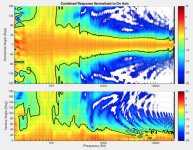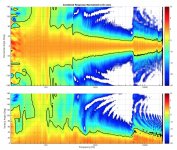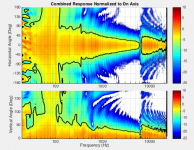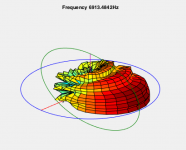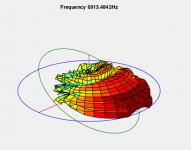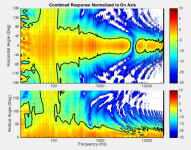Hi all,
I have read on several occasions, that to achieve a flat response both on-axis and off-axis, the design of the crossover(passive) plays an important role.
Assuming a 2-way system, we might be able use eg. ribbon tweeters with a broader horizontal dispersion to improve the situation.
But can a flat response be achieved for Dome Tweeters with careful crossover design?
Help most appreciated!🙂
Neo
I have read on several occasions, that to achieve a flat response both on-axis and off-axis, the design of the crossover(passive) plays an important role.
Assuming a 2-way system, we might be able use eg. ribbon tweeters with a broader horizontal dispersion to improve the situation.
But can a flat response be achieved for Dome Tweeters with careful crossover design?
Help most appreciated!🙂
Neo
The first priority is to provide uniform dispersion pattern for all frequencies.
Especially, drivers should disperse similarly at the crossover frequencies.
Drivers should be selected small or thin enough not to be self-equalized by
narrowing on-axis response. Your crossover will then have to provide the
missing equalization, called "CD" or "Constant Directivity". Advantage now,
your EQ requires the same corrections for both off-axis and on-axis...
There is some threshold of low frequency where front-side pattern control
is lost, and sound wraps around to the back. The baffle step. Again your
crossover, in addition to crossing, should probably try to flatten this step.
Passive crossovers are affected by driver impedance. Crossover may need
Zobels to flatten anomalies in each driver's impedance. Except where flaws
may be put to good use, perhaps even aggravated, to achieve some of the
above mentioned equalizations.
You may desire to add series resistance to tweeter to attenuate, and give a
rising "CD" response with frequency. Though also aggravates Q to become a
resonant problem, even with a zobel. But could be hidden if that peak is well
below the tweeter crossing. There are some advantages to drive a tweeter
with a high impedance source of low damping. As such electrical damping may
occur out of phase with mechanical problems it hoped to correct, only makes
the uncorrectable situation worse.
All these considerations go into a crossover.
Especially, drivers should disperse similarly at the crossover frequencies.
Drivers should be selected small or thin enough not to be self-equalized by
narrowing on-axis response. Your crossover will then have to provide the
missing equalization, called "CD" or "Constant Directivity". Advantage now,
your EQ requires the same corrections for both off-axis and on-axis...
There is some threshold of low frequency where front-side pattern control
is lost, and sound wraps around to the back. The baffle step. Again your
crossover, in addition to crossing, should probably try to flatten this step.
Passive crossovers are affected by driver impedance. Crossover may need
Zobels to flatten anomalies in each driver's impedance. Except where flaws
may be put to good use, perhaps even aggravated, to achieve some of the
above mentioned equalizations.
You may desire to add series resistance to tweeter to attenuate, and give a
rising "CD" response with frequency. Though also aggravates Q to become a
resonant problem, even with a zobel. But could be hidden if that peak is well
below the tweeter crossing. There are some advantages to drive a tweeter
with a high impedance source of low damping. As such electrical damping may
occur out of phase with mechanical problems it hoped to correct, only makes
the uncorrectable situation worse.
All these considerations go into a crossover.
Last edited:
Assuming a vertical driver arrangement, the crossover has no effect on horizontal dispersion, and only affects vertical dispersion in the range of the acoustical crossover.Hi all,
I have read on several occasions, that to achieve a flat response both on-axis and off-axis, the design of the crossover(passive) plays an important role.
But can a flat response be achieved for Dome Tweeters with careful crossover design?
Neo
Dispersion is dependent on the driver.
yes, directivity is largely a geometric problem - driver shape, size, waveguide, baffle shape...
XO can only change the transition between drivers, how their radiating geometry adds up
any EQ built into XO changes both on and off axis exactly the same for a driver
XO can only change the transition between drivers, how their radiating geometry adds up
any EQ built into XO changes both on and off axis exactly the same for a driver
Last edited:
Vertical narrrowing self-equalization of a ribbon may play to horizontal advantage.
May need less equalization than a uniformly dispersing dome. Still need to examine
impedance curves and decide if any look helpful to your required Eq, or will have to
build that function into your crossover.
On the other hand domes, already beginning with a rounded wavefront, may excuse
a bit wider driver than a flat ribbon and still disperse well.
May need less equalization than a uniformly dispersing dome. Still need to examine
impedance curves and decide if any look helpful to your required Eq, or will have to
build that function into your crossover.
On the other hand domes, already beginning with a rounded wavefront, may excuse
a bit wider driver than a flat ribbon and still disperse well.
Last edited:
Hi,
The facts are on-axis is far more important than off-axis.
If the only way of getting good on-axis gives poor off-axis
you've made some bad driver choices to mate together.
rgds, sreten.
The facts are on-axis is far more important than off-axis.
If the only way of getting good on-axis gives poor off-axis
you've made some bad driver choices to mate together.
rgds, sreten.
Hi all,
I have read on several occasions, that to achieve a flat response both on-axis
and off-axis, the design of the crossover(passive) plays an important role.
🙂
Neo
The design of the filter is important in the sense that you don't use too
shallow filter slopes meaning really simple 1st order electrical for the
drivers that are not meant to be so easily controlled. So you want
exemplary higher order acoustic slopes so the interaction between the
woofer and tweeter does not create FR irregularities. The sensible
approach to designing a filter is to choose one that will give you
reasonably flat response in the listening window which would be a
combination of say +/- 20 deg or so horizontally and +/-10
deg vertically.
Assuming a vertical driver arrangement, the crossover has no effect on horizontal dispersion, and only affects vertical dispersion in the range of the acoustical crossover.
Dispersion is dependent on the driver.
This is not entirely correct. The complete polar response can be effected by the crossover and drivers chosen (both horizontal and vertical). For example, I have a vertical array of drivers, and I can make the horizontal polars wildly different around the crossover point through the crossover design I choose. Below are polar maps for a low order crossover on the left and a high order crossover on the right with the same drivers and physical arrangement.
Attachments
John,This is not entirely correct. The complete polar response can be effected by the crossover and drivers chosen (both horizontal and vertical). For example, I have a vertical array of drivers, and I can make the horizontal polars wildly different around the crossover point through the crossover design I choose. Below are polar maps for a low order crossover on the left and a high order crossover on the right with the same drivers and physical arrangement.
For the case you present, at least on axis, it appears I was entirely wrong 😱.
Your polar map shows the combination of a woofer narrowing in it's upper range combined with a tweeter widening in it's lower range, when the two are combined on axis using a low order order crossover the overlap results in dispersion averaged between the two native dispersion patterns.
Does the horizontal averaging of the driver's response with the low order crossover remain the same when off axis in the vertical domain?
In other words, if you measure the horizontal polars 20 degrees off axis vertically up or down, is the average still the same, or does it reflect the native dispersion pattern of the woofer and tweeter?
Art
Art,
My example is a 15" woofer, big midrange horn, and small horn tweeter. If I look at the same data at 20 degrees up (but still normalized to zero degrees), I get the polar maps below - the horizontal looks about the same except you see a dip from the vertical comb filtering around crossover - what you're seeing in the vertical polar map. I also included a balloon plot to help better visualize what's going on. The left two are the high order crossover, right is the low order.
My example is a 15" woofer, big midrange horn, and small horn tweeter. If I look at the same data at 20 degrees up (but still normalized to zero degrees), I get the polar maps below - the horizontal looks about the same except you see a dip from the vertical comb filtering around crossover - what you're seeing in the vertical polar map. I also included a balloon plot to help better visualize what's going on. The left two are the high order crossover, right is the low order.
Attachments
In John's examples xo point appears to be exceptionally high - around 6kHz. This addresses how important it is to set xo point (F) and type in a way that gives smoothest response on and off-axis!
We have many examples of this, both good and bad.
We have many examples of this, both good and bad.
I measured 703 points, although 54 of them were duplicates (back and top points). I have an automated setup so I just let it do it's thing.
Oh, man, I'm jealous! I get hinky after getting ten or fifteen points.😀
How is the automated system set up? Is the speaker moved or the mike? Or both?
How is the automated system set up? Is the speaker moved or the mike? Or both?
jcx - that looks amazing! I've been wanting to get full 3d polars but haven't looked into it much yet. John, is that what you have to work with?
- Status
- Not open for further replies.
- Home
- Loudspeakers
- Multi-Way
- On axis and off axis response
